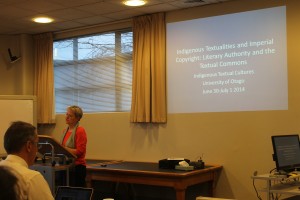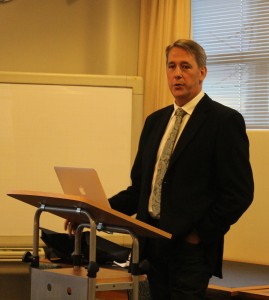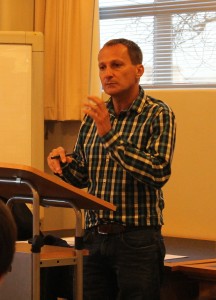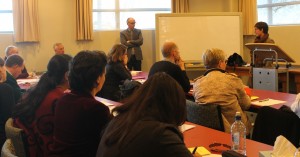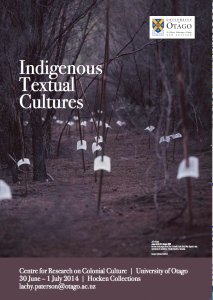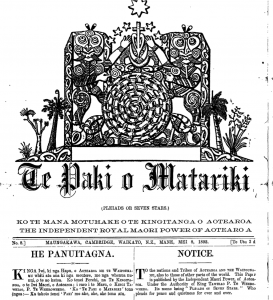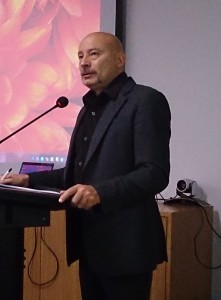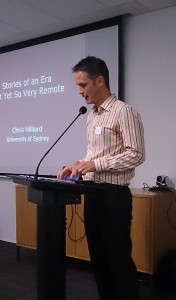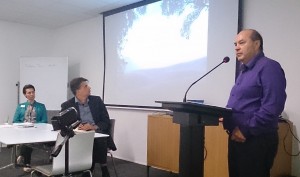Successful symposium on Indigenous Textual Cultures
The Centre was pleased to hold the Indigenous Textual Cultures symposium this week, an event that attracted a number of scholars from around the world interested in the history of indigenous peoples’ engagement with texts, and textual culture. Mark Brunton, Research Manager Māori gave a mihi whakatau (welcome) to open the event, which was held at the wonderful Hocken Collections, one of New Zealand’s premier research libraries and archives. A full hour was assigned for each presentation, allowing for depth of discussion within a focused event.
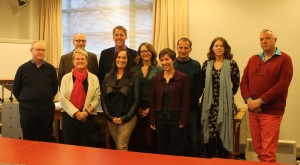
Presenters from left: Michael Reilly (Otago); Isabel Hofmeyr (Witswaterand); Tony Ballantyne (Otago); Keith Thor Carlson (Saskatchewan); Ārini Loader (VUW); ; Anna Johnston (Tasmania); Laura Rademaker (ANU); Bruno Saura (Polynésie Française); Emma Hunter (Cambridge); Lachy Paterson (Otago). Absent: Noelani Arista (Hawai’i)
See programme for full details and abstracts.
Although there are of course specific differences in how indigenous peoples of various localities and time periods engaged with literacy and texts, the symposium was extremely valuable in generating conversation, and a publication is planned from research presented. We would like to thank the locals who came along to listen, as well as several from the North Island. In particular we would like to thank Julie Gough for the amazing poster image, and the Hocken Collections for all their support.
Indigenous Textual Cultures Symposium
Tēnā rā koutou.
On 30 June and 1 July the Indigenous Textual Cultures Symposium will be held in the Seminar Room at the Hocken Collections. The Centre is excited to host this event, with leading academics from South Africa, North America, Australia, New Zealand and the Pacific presenting research looking at how indigenous peoples interacted with literacy and texts during the colonial period.
Check out the programme and the presenters’ Abstracts.
All interested staff, students and members of the public are most welcome to attend. There is no fee for attendance but please RSVP to lachy.paterson@otago.ac.nz so that we have some idea about numbers for catering.
Environmental History Symposium
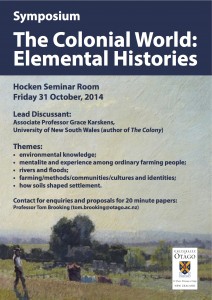 Paper proposals are now being invited for an upcoming CRoCC event, an environmental history symposium at the Hocken Collections, University of Otago, Dunedin. It will be held on 31 October, and feature an address by Associate Professor Grace Karskens (University of New South Wales), author of The Colony.
Paper proposals are now being invited for an upcoming CRoCC event, an environmental history symposium at the Hocken Collections, University of Otago, Dunedin. It will be held on 31 October, and feature an address by Associate Professor Grace Karskens (University of New South Wales), author of The Colony.
If you are interested in presenting a paper or you want to attend the event please contact Professor Tom Brooking (tom.brooking@otago.ac.nz).
“Tino Rangatiratanga: a Constitutional Problem Child?”
Lachy Paterson, “Tino Rangatiratanga: a Constitutional Problem Child?”
This is the text of a presentation given at Centre for Research on Colonial Culture event, Colonial Origins of New Zealand Government and Politics, Dunedin, 8 March 2013.
The Treaty of Waitangi is important, perhaps central, to current discussion on New Zealand’s constitution. The government established the Constitutional Advisory Panel largely at the instigation of the Māori Party, who in their own press release squarely saw the review in terms of the Treaty.[1]
Now in 2011, we have a great opportunity to make good on that invitation, to breathe new life into the call from the people to honour the Treaty.
‘On December 8, both parties announced a wide-ranging review to include matters such as the size of Parliament, the length of the electoral term, Māori representation, the role of the Treaty and whether New Zealand needs a written constitution.
The “role of the Treaty” sits within the Panel’s Terms of Reference, and the Treaty features prominently in the panel’s publication, The Conversation So Far.[2] In addition it is the role that the Treaty might play in our country’s constitutional future that is most contentious. For example, ‘in response to the Maori Party’s plan to replace our constitution with one based on the Treaty of Waitangi to give the tribal elite supreme power in New Zealand’ the right-wing New Zealand Centre for Political Research set up its own Independent Constitutional Review of politicians and academics. Without appearing to have consulted with anyone, this body has rejected the Treaty and its principles out of hand.[3]
What is not being talked about, yet is surely implicit, is what is so attractive, or so noxious about the Treaty and its place within the constitution, the concept of “tino rangatiratanga”, and what constitutional rights Māori might get that others will not, and how will these rights might impinge on others. Despite the Treaty’s prominence in The Conversation So Far, including five pages specifically to its role, the only attempt to define rangatiratanga that I can find is that the Treaty gave chiefs ‘absolute authority for chiefs (or rangatira) to be chiefs and to hold sway in their territories’. The document also states that ‘The Waitangi Tribunal is responsible for defining what the Treaty means in a modern context’, something that actually appears beyond the scope of the Treaty of Waitangi Act.[4] In the event of a written constitution, I would imagine, for both judicial and political reasons, that courts will be tasked with defining rangatiratanga rights rather than the Tribunal.
As we all know, there are differences between the English-language Treaty of Waitangi and the Māori-language Te Tiriti o Waitangi. To a large extent, current academic assumptions of Te Tiriti stem from Ruth Ross’s essay in 1972 which suggests that Māori saw kāwanatanga (government) as somewhat limited in scope, certainly not the sovereignty ceded in the Treaty, and that the guarantee of tino rangatiratanga was significantly more than mere ownership of land and possessions.[5] Ross’s observations were not necessarily new: Māori had been saying this at least a century earlier, and New Zealand’s first Chief Justice, Sir William Martin, before that. Ross’s interpretation happened to emerge concurrently with educated urban Māori asserting their rights and grievances, and has since fostered a new Treaty orthodoxy, at least as lip service, within church, state, and academia. However, notwithstanding the largely homogeneous nature of this public “treaty discourse”, there is no real consensus on what rangatiratanga might actually mean in practice, to Māori, or to Pākehā.[6] What Pākehā may have to give up, to placate the unknown of rangatiratanga, remains for them, a continuing site of unease. Rangatiratanga is obviously not a straightforward concept. Nor was it so during New Zealand’s colonial past. The point of this discussion is to investigate the term, rangatiratanga, within historical contexts. Hopefully this will stimulate some debate. What did rangatiratanga actually mean during New Zealand’s colonial past, and why might this be relevant for the panel.
Rangatiratanga is a derived noun: rangatira means chief or chiefly, while rangatiratanga denotes abstract qualities, such as, according to the Williams Dictionary ‘evidence of breeding and greatness’. Given that Māori society was hierarchical, and that superior whakapapa (or breeding) gave one greater standing and mana (power and authority), rangatiratanga was thus a positive attribute. Lyndsay Head, sifting through Ngā Mahi a ngā Tupuna, a volume of Māori traditions, claims that mana related only to religious contexts, and that rangatiratanga was reserved for worthy behaviour rather than political power. Head also asserts that rangatiratanga was a Pākehā construction, a ‘semantic improvisation’ to translate the new concepts of power and authority Māori were encountering, and that ‘it fitted the new world better than the old, hence its scarcity in accounts of the former.’[7]
When Pākehā, such as missionaries, sought to introduce words for new items or concepts into Māori, they sometimes employ loanwords, such as Paipera for Bible, hoari for sword, Hīhā for Caesar. However, for more metaphysical concepts, they often borrowed Māori words with a similar meaning. They added an additional specific definition, the subtleties of which they would then need to explain to Māori. Thus atua (spiritual entity) and tapu (restricted) have pre-contact meanings, but also gained Christian definitions. When missionaries were looking for a term to translate “kingdom” (or similar terms) they often used rangatiratanga, building on its attributes of chiefliness, hierarchy and status. The word appears over 200 times in the Māori Bible, mostly in the New Testament where it is commonly used for the higher kingdom of God, although it was also used to used to define more earthly realms. The word kīngitanga was also used for kingdom, although mostly in the Old Testament. The transfer of rangatiratanga for kingdom from spiritual to secular can be seen in this 1831 land deed, where the United Kingdom is described in terms of rangatiratanga.[8]
…na taua Kirepeti Mea kaihanga kaipuke o te kainga i huaina ko Pitahere, i Koterani no nga rangatiratanga huihui o Piritane Nui, a Airirani.
“…whereas the said Gilbert Mair shipbuilder by trade, of and from the town or place called Perhead of Scotland in and of the United Kingdom of Great Britain and Ireland…”
But what of political authority? In these two examples from the 1840s, we can see Māori using rangatiratanga in terms of abstract political power. This goes beyond mere personal qualities, even if – according to Head – this had not been the case in pre-contact times.[9]
…engari au e rima rau oku tangata i roto i toku rangatiratanga.
[…but I have 500 men within my chieftainship.]
…e kore ahau e hui i toku rangatiratanga ki to nga tangata o Wairarapa.
[…I will not associate my chieftainship with that of the people of Wairarapa.]
Given the context of the Māori scriptural lexicon of both heavenly and earthly kingdom, it is perhaps not surprising that missionaries, when translating the Northern chiefs’ 1835 Declaration of Independence, rendered the word ‘independence’, that of Māori chiefs, as ‘rangatiratanga’, and ‘all sovereign power and authority’ with ‘kīngitanga’ and ‘mana’. These were logical extensions of the Biblical lexicon. What is less clear is why missionaries, five years later, when translating the Treaty of Waitangi by which Britain annexed New Zealand, used rangatiratanga (with the intensifier tino) to define mere land possession in the second article. Head suggests that it was to downplay the fears of Northern chiefs about losing their lands.
However, as seen in the old land deed below, where missionaries, buying land just one month before the Treaty was signed, included the words mana and rangatiratanga in the Māori-language version of the deed to reinforce the nature of the transfer.[10]
…kua oti te tuku e matou e Panakareao ma ki te Hahi Mihanare tetahi wahi wenua oti tonu atu me nga rakau katoa me nga aha noa me nga aha noa katoa e tupu ana i taua wenua me nga mea katoa o raro i taua wenua, me te rangatiratanga me te mana i runga i taua wenua.
[…that I Noble Panakareao and tribe have sold to the Church Missionary Society a piece of land forever, trees and everything else that grows on it and all things below it.” [and the rangatiratanga and mana on that land.]]
Clearly rangatiratanga could also refer to land ownership.
Whatever the Māori understanding of the Treaty was, chiefs who signed thought that the rangatiratanga of their lands and taonga [valued possessions] was guaranteed, and Governor-to-be Hobson considered, once sufficient signed copies of the Treaty were back, that the Crown had gained sovereignty. However, Hobson was hardly in control. While Māori authority was real in 1840 – however it was defined –Crown sovereignty was liminal at best. The government sought to realise its sovereignty, which could only come at the expense of rangatiratanga. I think that this is signalled in the Treaty, where it talks not of rangatiratanga per se, but transitively; the rangatiratanga of things, including land. The Treaty’s second article also states that Māori who desired could sell their land to the Queen. This was one way that Crown control could be extended over the country, and by implication, rangatiratanga diminished.
In the two decades after the signing of the Treaty, the term rangatiratanga for the most part is absent from both governmental and recorded Māori discussions on the nature of institutional power, with the term mana – specifically “te mana o te Kuīni”, [the Queen’s mana] the preferred term. Rangatiratanga, however, developed new meanings in the colonial setting. It was being used to define Pākehā customs, and concepts such as civilisation, prosperity, and knowledge – all things that both missionaries and officials thought Māori should aspire to. The government did not use the term to define chiefly authority: it was proactive in directing all discourse on power, including the Treaty, and perhaps did not want to cloud the desired Māori acquiescence to Crown sovereignty with any notions of chiefly rule. For example, when Governor Browne reiterated the [government’s] principles of the Treaty to assembled chiefs at the Kohimarama Conference in 1860, the Māori re-translation of the second article avoided rangatiratanga completely, and his speech asserted that Māori ‘completely gave up to the Queen of England all the processes and mana of government that they all had, or that one or another of them had, and all things like that which they are thought/said to have’.[11] Browne also threatened that Māori who did not align with the Crown would lose the Treaty’s guarantees. In effect, it was the Crown of the 1860s that was holding up the Treaty – its interpretation – against any ideas of Māori autonomy.
Some Māori paid lip service to this colonial discourse, but those who did not – such as the Kīngitanga of the 1860s, and its sympathizers – saw the Treaty as a fraud. Its own newspaper, Te Hokioi, expressly rejected the Treaty, first because many chiefs hadn’t signed it, and second because those who had signed had been duped. It was a ‘covenant of the blind’.[12] The Kīngitanga defined its authority in terms of mana, in effect sovereignty, relating to land as yet unsold.[13]
…koia ra tenei me tu te mana o kingi potatau ki runga o nga wahi o Nui tireni e mau nei ki a tatou, me tu te mana o kuini ki runga i nga wahi kua riro atu ki a ia…
[…it is this, let the mana of King Pōtatau stand on the parts of New Zealand that we still hold, and let the mana of the Queen stand on the parts that she has obtained…]
It was in the 1870s, the early post-war period that what might be deemed a modern treaty discourse emerged, in which rangatiratanga was posited as something more than a guarantee of land ownership. This can be seen in the pages of the Māori newspaper, Te Wananga, which rendered rangatiratanga within its Treaty translations as both “dominion” and “the chieftainship”.[14] This was also the period when the Repudiation Movement was challenging some very dodgy land sales through the courts, and local Māori rūnanga were attempting to take control of decisions over land lest they be left to the Pākehā-controlled Native Land Court. Its successor, the Kotahitanga also engaged in these discourses. I imagine that the immediate post-wars period, when some of the naked realities of colonisation became apparent to Māori, that a Māori re-reading of the Tiriti became particularly attractive. This interpretation may have troubled the government, which produced a new translation of the English version in 1869. Sovereignty, formerly “kāwanatanga”, became “mana” and “rangatiratanga”, and the Article 2 guarantees, formerly “rangatiratanga”, were downgraded to mere “tūturutanga” (fixedness) of their lands.[15]
Ultimately the Treaty was a stick and carrot with which the government tried to impose Crown sovereignty up until the early 1860s. It was only useful to the government in the early stages of asserting its power, and once it had decided that coercion was the method to solve its problems, the Treaty lost its relevance to the Crown. We see this in 1877, when Māori were claiming rights in court based on Article 2, that Chief Justice, Sir James Prendergast, determined that the Treaty was “worthless” and a legal “nullity”.[16]
The Kīngitanga and the Crown made peace in 1882. In 1862 the movement had suggested that the Treaty was a fraud, and did not apply to those who did not sign it. After 1882, the Kīngitanga, like the Kotahitanga, promulgated a Tiriti-inclusive argument. This was not expressed in terms of rangatiratanga, but of mana, mana motuhake (or separate authority). However, the Kīngitanga now justified that mana on the basis of Treaty guarantees, rather than that the Treaty did not apply to them.
The dynamic nature of Māori opinion can be seen too in the words of Rēnata Kawepō of Ngāti Kahungunu. In 1860, he was sympathetic to the Kīngitanga and troubled by the Crown’s aggression in the first Taranaki War. For this reason he describes the Treaty as having failed.[17]
Inahoki kua he ano te Tiriti o Waitangi, i kiia ra hoki ko taua tiriti he Kawenata kei tikina mai e etahi iwi ke, te tae mai aua iwi kino ki te patu i a matou. Ka puta tonu mai i roto i a koutou i te iwi naana taua Kawenata nei te patu i a matou.
[Moreover, the Treaty of Waitangi has failed. That Treaty is said to be a Covenant lest [we] be taken by some foreign peoples. Those bad people did not come to attack us. The attack on us came from among you, the people who made that Covenant.]
However, in the following decade, due to the threat of the Pai Mārire movement to his chiefly position, Kawepō had re-aligned himself to the Crown and fought as their ally. By the 1870s, he was not totally content with the Crown’s actions, but saw his chiefly position best protected by the Treaty.[18]
Tenei toku kupu ki a koe, e takoto nui tonu ana taku mana, i tapiritia nei e te kupu a Te Kuini, ara, e tona Tiriti i Waitangi; e ki nei, ki au ano te mana o toku whenua.
This is my word to you, my mana, which was confirmed by [the Queen’s word, that is] the Treaty of Waitangi, still remains in force. The Treaty of Waitangi, which declared that the mana of my land should remain with me.
However, during this last quarter of the nineteenth century, despite the shift towards Māori viewing the Treaty as the bulwark of their rights, they tended not to use the term rangatiratanga in the context of these Treaty rights. Nearly always, the term used was mana. For example, the Repudiationist Hēnare Matua used mana to define land rights in 1876.[19]
Na te Tiriti o Waitangi i mana ai ta tatou pupuri i o tatou whenua, i mana ai nga Kooti, me nga mokete. Mei kore te Tiriti i Waitangi, kua penatia tatou me nga motu o te Ao nei.
[It was through the Treaty of Waitangi that our holding of our lands was empowered [mana] and that Courts and mortgages were empowered. If it were not for the Treaty of Waitangi, we would have been like other countries in the world’.]
A correspondent to Te Wananga also wrote, ‘You heard the word within the Treaty at Waitangi, that is, that the mana of the land should be left to the Māori people.’[20]
Why did Māori not use the term rangatiratanga to assert these rights? In the post-wars period, the government considered that it was gaining the upper hand. Māori were increasingly being pushed to the margins politically, and swamped demographically by immigration. Less concerned about civilisation or social customs, the Crown increasingly used rangatiratanga in its own discourses to Māori in the context of governmental power. The United Kingdom became “te Rangatiratanga Kotahi”, and the Queen’s sovereignty as “te rangatiratanga o te Kuini”.[21] The Crown continued to usurp the term in the services of colonisation, and even Te Wananga, a Māori-controlled newspaper, used rangatiratanga in the context of colonial or imperial power. Even the Kotahitanga, whose full name was “Te Kotahitanga o te Tiriti o Waitangi” based its right to exist, in its discourses of the 1890s, on tribal mana rather than rangatiratanga.
Not all post-wars Māori adhered to a Tiriti discourse. For example, James Carroll of Ngāti Kahungunu was a politician who, as can be seen in this discussion he had with Ngāti Tūwharetoa ariki, te Heuheu Tūkino V, promulgated a more positivist legal interpretation of the Treaty.[22]
124. . . .Te Heuheu: Ka korero atu au i taku ake whakaaro. Ae; kua takahia te wahi tuatahi o te rarangi tuarua o te tiriti.
125. Hon. Timi Kara: I peheatia te takahi?
Te Heuheu: Koia tenei, kaore ano ona tikanga i whakatutukitia. Ko nga mana mo nga Maori i whakatuturutia nei e taua rarangi kaore ano i hoatu ki a ratou.
126. Hon. Timi Kara: Kaore ano koia i hoatu nga taitara o o ratou whenua ki a ratou?
– – –
124. … [te Heuheu] I will give my own opinion. Yes; the first provisions of the second article of the treaty have been broken.
125. [Carroll] How?
[te Heuheu] It has been trampled on in this way: it was never given effect to. The rights which that article assures to the Natives have never been given to them.
126. [Carroll] Have they not got titles to their lands?
Carroll was a mentor to Āpirana Ngata, leader of the Young Māori Party. This new movement saw Māori society as in need of reform to improve it socially, materially and spiritually. Ngata didn’t see this as achievable through striving for self-determination, but through better education and engagement with the parliamentary processes.[23] In 1922 Ngata published a series of articles on the Treaty in Te Toa Takitini in which he stated that Māori who sought mana Māori motuhake through Article 2 were mistaken. Sovereignty had been ceded to the Crown through Article 1, and rangatiratanga pertained to property ownership.[24]
Ka puta nga wawata a nga Ropu Maori ki te mana Maori motuhake, ahakoa kiia he Kotahitanga, he Kauhanganui, he Paremata Maori he aha ranei te ingoa, e hoki ana aua wawata ki tenei upoko o te Tiriti. Otira na te pohehe i pera ai. Ara kei te mana o te Maori kua tapaetia atu e te Upoko Tuatahi o te Tiriti mo ake tonu atu.
[Various Māori groups, whether Kotahitanga, Kauhanganui, Māori Parliament or some other name, have yearned for separate Māori authority and those dreams go back to this [second] article of the Treaty. But it is from mistakenness that they think so, because the mana of the Māori people has been covered over by the First Article of the Treaty forever more.]
The Young Maori Party saw the Māori race as in danger of extinction, not just culturally but as an actual people and pragmatism was the only way to save it. In contrast, the religious and political leader, Tahupōtiki Rātana, who also sought to save the Māori people, regarded the Treaty of Waitangi as of pivotal importance to his mission.
So what does this mean for the Constitutional Review? Unfortunately, most publically espoused positions fall into two opposing poles. On one side are those who wish to avoid addressing the Treaty. At least, they are happy to accept the Treaty having given the Crown sovereignty, but not that rangatiratanga ascribes any special rights to Māori. The New Zealand Centre for Political Research and its own Independent Constitutional Review fit this bill. On the other hand, the Crown, churches, iwi and many academics all believe that the Treaty is of fundamental importance to modern New Zealand society. For example, church and union groups – non-state agencies – still see a need for a ‘Tiriti partnership relationship’.[25] Some have described the Treaty as “sacred”, or as one Presbyterian minister told his congregation, a “secular scripture”.[26] Although many agree on the importance of rangatiratanga, there can be quite marked differences in interpretation. For example, Network Waitangi assert that the term equates with ‘the continuance of Maori authority and sovereignty’[27] whereas recent statements from the judiciary or Waitangi Tribunal talk more of resource management, or woolier terms, such as ‘a claim to an ongoing distinctive existence as a people’,[28] or ‘self-management’ or ‘self-regulation’,[29] or ‘full authority status and prestige with regard to [Maori] possessions and interests’.[30] In the case of the Mangonui Sewerage Report, rangatiratanga is the right to be consulted.[31]
The Treaty is important to the constitution. It is a mechanism through which Māori can engage collectively with the state. However, the Treaty’s past is far less cut-and-dried than it is sometimes portrayed. The historian can point this out, but it is for other professions to determine political and legal truths for today. However, there are four key points from this talk that I would like to stress.
First, that rangatiratanga has meanings outside of the Treaty, including notions of prosperity and civilisation, and even God’s heavenly kingdom.
Second that it was largely absent from Treaty discourses, or merely implied, for most of the nineteenth century. What’s now expressed as rangatiratanga was more commonly known as mana. Its other meanings, and the Crown’s appropriation to define colonial rule, meant that it was not often used to define Māori treaty rights. However, this not mean those rights did not exist.
My third point is that during the colonial period Māori attitudes and opinion towards the Treaty, and by implication rangatiratanga, had more to do with the pragmatics of politics than enduring principles. Some Māori barely considered the Treaty before the 1860s. In 1860, the Governor asserted the Queen’s sovereignty as the Crown’s treaty right, and threatened the removal of Treaty guarantees from Māori who did not accept this. Perhaps understandably the Kīngitanga, attempting to create a Māori state, rejected the Treaty. In the post-wars period, as the state endeavoured to further impose its power over Māori, movements such as the Kotahitanga and the Kīngitanga promoted the Treaty as the bastion of their rights. In the early twentieth century Ngata, seeing more benefit for Māori through working within state institutions, rejected the tino rangatiratanga discourse and asserted Crown sovereignty.
My fourth and final point is, when determining constitutional niceties for the twenty-first century, it does not hurt to remember the messiness of the past.
NOTES
[1] Māori Party Press Release, Constitutional courage, constitutional change, January 2011, http://www.maoriparty.org/
[2]Constitutional Review Panel, New Zealand’s Constitution: The Conversation So Far, September 2012. http://www2.justice.govt.nz/cap-interim/
[3] http://www.nzcpr.com/ConstitutionalReview.htm ; http://www.nzcpr.com/petition_EqualRights.php
[4]The Conversation So Far, p.8.
[5] Ruth Ross. ‘The Treaty of Waitangi: Texts and Interpretations’, New Zealand Journal of History, 6, 2, 1972, pp.129-157.
[6]Macalister, John. 2008. ‘Tracking Changes in Familiarity with Borrowings from te Reo Māori.’ Te Reo 51, p. 85.
[7] Lyndsay Head ‘The Pursuit of Modernity in Maori Society: The Conceptual Bases of Citizenship in the Early Colonial Period’ in Andrew Sharp & Paul McHugh (eds) Histories, Power and Loss: Uses of the Past – A New Zealand Commentary Wellington: Bridget Williams Books, 2001, pp. 106-7.
[8] H. Hanson Turton, Maori Deeds of Old Private Land Purchases in New Zealand from the Year 1815 to 1840, with Pre-Emptive and Other Claims, Wellington: Government Printer, 1882, pp. 76, 78.
[9] Letter from Kawana Hakeke to McLean, Aug 1848. Alexander Turnbull Library, MS-Papers-0032-0672C-06. Object #1031502; Letter from Hakaraia Te Rangiwakatakaura, Te Retimana to Te Kepa and Te Pere, 28 Nov 1848. Alexander Turnbull Library, MS-Papers-0032-0672E-08. Object #1031091.
[10] H. Hanson Turton, Maori Deeds of Old Private Land Purchases in New Zealand from the Year 1815 to 1840, with Pre-Emptive and Other Claims, Wellington: Government Printer, 1882, p.3.
[11] TKM 14/7/1860: 6. Translation of Māori text. ‘…tino tukua rawatia ana e ratou ki te Kuini o Ingarangi nga tikanga me nga mana Kawanatanga katoa i a ratou katoa, i tenei i tenei ranei o ratou, me nga pera katoa e meinga kei a ratou.’
[12] Te Hokioi, 15/2/1862: 2.
[13] Te Hokioi, 8/12/1862: 2.
[14] Te Wananga, 22/1/1876 p.38; 3/6/1876, p.215.
[15] Appendix to the Journal of the Legislative Council, 1869, p. 68.
[16] Wi Parata v Bishop of Wellington (1877) 3 NZ Jur (NS) 72 (SC).
[17] Rēnata Kawepō. ‘Letter Answering the Letter of Thomas Fitzgerald, The Superintendent of Napier, H.B. Pā Whakairo, February 1861.’ Folios 30 & 31, McDonnell Papers, MS-Papers-0150 [ATL].
[18] Rēnata Kawepō, addressing Sir George Grey. 15/1/1877. Te Wananga, 29/1/1877, pp.507, 510.
[19] Te Wananga, 15/4/1876: 167.
[20] Te Wananga, 21/2/1876: 77.
[21] Te Waka Maori o Niu Tirani, 15/12/1874: 311; 29/12/1874: 322)
[22] Appendix to the Journals of the House of Representatives, 1898 Session I, I-03a.
[23] In 1897 he stated that people who knew Māori, ‘would not sympathise with the leaders of the [Kotahitanga] movement in their efforts to secure Home Rule and the power to legislate and administer Native Lands. The time would be better spent in agitating for the increase in Maori representation in Parliament…’A.T. Ngata ‘Maori Politics and Our Relation Thereto’, in Papers and Addresses read Before the First Conference of the Te Aute College Students Association, February, 1897 (Gisborne: Herald Office, 1897) p.34
[24] Te Toa Takitini, 1/6/1922, p.6.
[25] Example from Tertiary Education Union: Te Hautū Kahurangi o Aotearoa, Te Tiriti o Waitangi – TEU Policy, http://teu.ac.nz/2011/12/te-tiriti-o-waitangi-teu-policy/, Updated 8 December, 2011.
[26] Allan Davidson, Waitangi Day, 2011. The Community of St Luke, Accessed 18 March, 2014. http://www.stlukes.org.nz/?sid=42527
[27] Network Waitangi, Treaty of Waitangi: Questions and Answers, 4th revised edition, (Christchurch: Network Waitangi, 2012), p.12. http://nwo.org.nz/files/QandA.pdf
[28] Janine Hayward, “Principles of the Treaty of Waitangi”, appendix to the National Overview. (Taiaroa v the Minister of Justice (1994), p. 482.
[29] Hayward (Manukau Report, p.486; Ngawha Geothermal Resources Report, p.492)
[30] Hayward (Manukau Report, p.486.)
[31] Hayward, p.492.
Cowan Symposium. Cultural Go-Between, Colonial Man: New Perspectives on James Cowan.
A successful one-day symposium was held at the National Library on Friday 21 February, a joint event run by Annabel Cooper of the Centre for Research on Colonial Culture and Ariana Tikao of the Alexander Turnbull Library. It attracted more than 65 attendees, including academics, librarians, archivists, professional and governmental historians, and other interested people. Chief librarian of the Alexander Turnbull Library, Chris Szekely, welcomed people to the event, and suggested that it was a good start to CROCC’s relationship with the Turnbull and National Library, and hopefully the first of many events. Chris’s welcome was followed by a mihi from the Turnbull’s Curator Māori, Paul Diamond.
Chris Hilliard (University of Sydney) returned to Cowan, a subject of research earlier in his career, with the keynote address ‘Stories of an Era Not Yet So Very Remote’ in which he asked us to look beyond Cowan’s grand statements – ones with which he can so easily be tied to the colonial project – to his love of detail, and it was through these that we could get a better understanding of the man. Chris stressed Cowan’s love of New Zealand history, and his connection with place and people.
The themes that Chris set out were picked up by the three speakers who followed. Paul Meredith of Ngāti Maniapoto, like Cowan, grew up in the Kihikihi area, and values the writer’s work, in particular his oral history, as a means of unlocking the voices of his tūpuna. He pointed out too that Cowan collaborated with Raureti Te Huia and the methods they used have parallels with the kaupapa Māori methodology of today.
Te Kenehi Teira of Ngāti Raukawa, Kaihautu Māori for the Historic Places Trust, spoke about the Trust’s development of interpretation and other resources for the Ōrākau commemorations, and a smartphone driving app for the Waikato battle sites. As Te Kenehi said, the app was a means of bringing Cowan into the modern world. The researchers utilised Cowan’s writings as a means of adding detail to the interpretations, and in the case of Ōrākau, of pinpointing the actual site of the pā.
This session was closed by Ariana Tikao of Kāi Tahu, Research Librarian Māori, who discussed the Turnbulls’ recent acquisition and description of 202 folders of Cowan manuscript material (acquired at the end of 2012) that now complements the Library’s existing collection. Ariana also talked about putting together Borderland: The World of James Cowan, (running to 26 April in the Alexander Turnbull Gallery), her exhibition exploring the writer’s life, work and legacy.
After lunch, we heard from Greg Woods who talked on Cowan’s years as a journalist at the Auckland Star (1888-1903). During this time Cowan wrote at least 370 feature articles, some of which he incorporated into his later books. Cowan was a “Māori specialist” perhaps due to his language skills, and unlike most reporters of the time, was able to add his name to these articles. While also shipping reporter Cowan met some famous writers, such as Rudyard Kipling, Mark Twain and Robert Louis Stevenson, and Greg argued that Cowan took Stevenson as a sort of literary model for his writing. Kathryn Parsons, Special Collections Librarian at the University of Waikato, discussed Cowan’s later writing for children in The Enzed Junior, a weekly Saturday supplement that ran from 1934 to 1941. Cowan wrote 255 articles for this publication, 190 of which were on Māori-related topics. Staying with young people, the final speaker in this session, Jim Frood, a history teacher at Kings College, Auckland spoke on the secondary schools history curriculum and the value of Cowan’s work as a resource in the teaching of Year 11-13 history.
Roger Blackley of VUW began the last session with a discussion on Pictures of Old New Zealand, comprising Lindauer portraits of Māori men and women with bibliographical information supplied by Cowan. Roger showed how Cowan re-used text written by earlier writers, such as James Mackay, but moderating some of the sentiments for the sensibilities of his own day. Although Cowan’s writing is about the people, rather than the art itself, Roger argued that Pictures of Old New Zealand might be considered New Zealand’s first art monograph. Lydia Wevers (Stout Centre, VUW) then spoke about Cowan’s travel writing, in particular his work on the Main Trunk Line written for railway tourism purposes. This work shows Cowan’s contradictory attitudes to colonialism, on the one hand accepting the inevitable march of progress, while also lamenting the loss of the bush, and the old Māori ways of life. Annabel Cooper (University of Otago) and Diane Pivac from New Zealand Film Archive, looked at Cowan’s influence on New Zealand films of the New Zealand Wars, from Rudall Hayward (for whom he worked as an advisor) to Geoff Murphy’s Utu, which was inspired by one of Cowan’s stories, to Vincent Ward’s River Queen. We were treated to excerpts from Hayward’s Te Kooti Trail, a silent movie in which Hayward used descendants of the historical figures as actors, and his last movie, Rewi’s Last Stand. Tony Ballantyne (University of Otago and CROCC Director) wrapped up the day, reminding us that Cowan is a more complex personality than superficial reading of his work might suggest.
Cowan Symposium: Registration Closes Soon
If you are planning to attend the James Cowan Symposium (21 February) in Wellington, please remember to register for it via registration portal (click the highlighted text). Registration costs $50 and closes on Monday February 17th, so get in quick!
Cowan Symposium: Draft Programme
The draft programme for the forthcoming James Cowan Symposium (21 February at the National Library, Wellington) is now available.
SCHEDULE
9-9.30: coffee, muffins
9.30-10.45: Mihi and welcome followed by a Keynote lecture from Chris Hilliard, University of Sydney
Chair: Annabel Cooper
Coffee
11.00-12.30: Session One (Chair: Paul Diamond)
Robert Joseph and Paul Meredith/On The Maniapoto O&T Report
Te Kenehi Teira/Historic Places on Rangiaowhia/recording sites
David Green /Commemorating Chivalry and Unity?
Lunch
1.30-3.00: Session Two (Chair: David Colquhoun)
Ariana Tikao/ Tales from the Border
Kathryn Parsons/ The Enzed Junior
Jim Frood/ Cowan for Secondary School Students
Coffee
3.15-5.00: Session Three (Chair: Angela Wanhalla)
Roger Blackley/ The Plutarch of Maoriland
Lydia Wevers/ Romance of the Rail
Annabel Cooper and Diane Pivac/ Filmed History: Cowan’s Screen Legacy
Wrap-Up Comments: Tony Ballantyne, University of Otago
5.30 Drinks
Register for the James Cowan Symposium
The registration portal for the Cultural Go-Between, Colonial Man: New Perspectives on James Cowan Symposium is now open. Click on the highlighted text, which will take you to the portal.
The Cowan Symposium is co-hosted by the Alexander Turnbull Library, and takes place at The National Library in Wellington on 21 February 2014. Keynote speaker is Associate Professor Chris Hilliard, University of Sydney.
James Cowan Symposium
A reminder that abstracts for the James Cowan Symposium (to be held in early 2014), co-hosted by the Centre for Research on Colonial Culture and the Alexander Turnbull Library, are due by 30 September. More details about the event can be accessed here: Cowan Symposium ePoster
Cowan Symposium Call-for-Papers
Call for Papers
New Perspectives on James Cowan
A One-Day Symposium
Centre for Research on Colonial Culture and the Alexander Turnbull Library
National Library, Wellington, 21 February 2014
James Cowan is best known for his official history of the New Zealand Wars, but his significance for the production and circulation of knowledge about Māori in the late colonial era covered a broad range of subjects. Alan Mulgan wrote after Cowan’s death in 1943 that more than anyone else, he had ‘shown us how to think as New Zealanders’. Mulgan signaled here not only Cowan’s prolific writing, but also his cross-cultural engagement from the 1890s to the 1940s. He was himself a figure of the type he so admired: the cultural go-between. Although his work often purveys the racial ideologies of his time, Cowan’s early use of oral historical methods, and familiarity with a wide range of Māori informants, effected the transition to print of much that would not otherwise have been circulated in Pākehā contexts, or recorded in print.
Cowan’s reputation has fluctuated in response to shifts in cultural politics, writing and historiography. His work began to attract contemporary scholarly attention with an article by Chris Hilliard in NZJH in 1997. Stories of the New Zealand Bush has been republished recently with a critical introduction by Alex Calder. The Adventures of Kimble Bent was read on National Radio in 2011, and re-written as a graphic novel, and film-makers have drawn on his work over decades. Some dimensions of Cowan’s work invite closer study: his significance for iwi history, his photographic collection, and the personal life of this particularly colonial figure, for example, would repay investigation.
For this one-day event, we invite papers which evaluate Cowan’s contribution to colonial encounter and colonial memory from a wide range of perspectives.
Please send abstracts (up to 250 words) and a bio (up to 100 words) in a Word attachment, by 30 September 2013.
Abstracts and enquiries should be sent to: cowan.symposium@otago.ac.nz
Further information about the symposium will be forthcoming.
Associate Professor Chris Hilliard, University of Sydney, will give a concluding commentary.
Convenors
Annabel Cooper (Centre for Research on Colonial Culture, U of Otago)
Ariana Tikao (Research Librarian, Māori, Alexander Turnbull Library),

